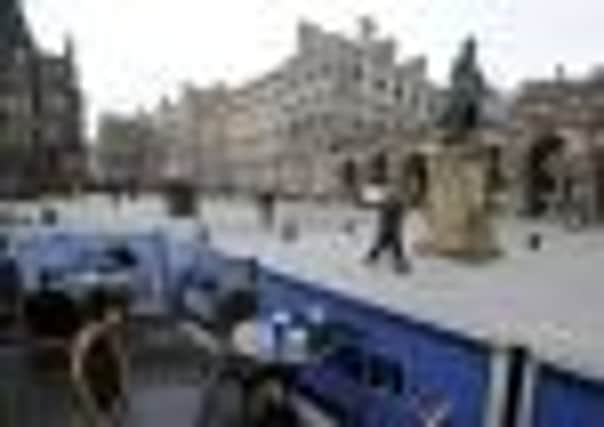Royal Mile car ban mooted under new council plan


City leaders say they want to build on the success of the semi-pedestrianisation of the section of High Street near the City Chambers by introducing similar measures to as much of the Mile as possible.
That would mean banning all traffic except for buses and cycles from the High Street between Blackfriars Street and the junction with Jeffrey Street and St Mary’s Street, though access would be allowed between 6.30 and 10.30am.
Advertisement
Hide AdAdvertisement
Hide AdCars would be allowed to continue using the remainder of the Royal Mile between Jeffrey Street and the Palace of Holyroodhouse, but the road would be raised to the same level as the pavement outside Canongate Kirk to create a “shared space” in a bid to slow traffic and talks are under way with the palace and the Scottish Parliament about the roundabout with Abbeyhill and Horse Wynd.
At the top of the Royal Mile, traffic restrictions are planned for both the Lawnmarket and Castlehill, but the details have yet to be worked out.
City planning convener Councillor Ian Perry said making the Mile more pedestrian-friendly would benefit tourists, traders and residents.
He said: “When we first proposed the measures we now have between Cockburn Street and George IV Bridge, there was a lot of resistance both from residents and mainly from traders. But we went ahead with the scheme and I suspect if you talked to some of the traders who were around at the time and suggested we go back to the way it was they would throw their hands up in horror because it has been a massive success, particularly for them as traders.
“The basic principle is cars don’t shop, people shop.”
The new measures, outlined in the draft Royal Mile action plan, are also aimed at encouraging more tourists to visit the bottom of the Mile. At the moment, the palace and the parliament get only one third as many visitors as the Castle.
“We’re losing one in three people between the top of the Royal Mile and the bottom,” said Cllr Perry. “People walk as far as Jeffrey Street but don’t go any further. We hope creating a pedestrian space halfway down, outside the Canongate Kirk, will encourage them all the way.”
The theory is that from the Jeffrey Street junction, visitors will see the distinctive area outside the church and be encouraged to continue their exploration.
Cllr Perry said the council was also keen to tackle the issue of “tartan tat” in the Royal Mile. The blueprint includes stricter control of street clutter and tougher restrictions on shop leases. Cllr Perry said: “If you lease a shop from the council there is a standard – a picture – to tell you what will be acceptable in terms of the frontage. If you don’t conform to that you are breaking your lease. “So far as privately owned shops are concerned, we have agreed to look at how we can get shopkeepers to comply voluntarily with the standard we set for displays outside shops.
Advertisement
Hide AdAdvertisement
Hide Ad“We’re trying to get the retailers to sign up to a code which removes the tartan tat. It’s not up to the council to tell people what they can sell in their shops. What the council has control over is what the shop looks like.”
He said the council had powers to remove goods which were placed outside shops. “If they have stuff on the pavement, we can take it away. That has happened.”
A Royal Mile Charter is to be drawn up with businesses over the next year to tackle graffiti, trade waste and the display of goods outside shops.
The action plan also covers the “hinterland” of the closes off the Royal Mile, which are said to have “considerable potential” to contribute to the success of the area. Restaurants, craft businesses and other small-scale enterprises could help bring activity into the closes.
The consultation on the action plan begins next month. Councillors are expected to consider it in the autumn and measures could be implemented early next year.
No more top decks?
DOUBLE decker and open-top sightseeing buses could be banned from the world-famous thoroughfare under the proposals.
The move would see Lothian Buses replace double deckers on the Number 35 route with single deckers.
Planning convener Ian Perry said: “We are looking at how we can deal with anything that is seen as having a negative visual impact on the Royal Mile and huge big double decker buses came up as a discussion point.”
Advertisement
Hide AdAdvertisement
Hide AdBut a switch to single deckers would probably mean an increased number of buses on the route.
Cllr Perry said: “Clearly if it’s going to increase pollution levels that would not be good.”
There could also be moves to restrict tourist buses on parts of the Royal Mile.
Cllr Perry added: “If you are having shared space between traffic and pedestrians, the less traffic there is the better.”
One option could be to introduce a low-emission zone. Many of Lothian Buses’ vehicles would meet the emission standards required to enter such zones, but tourist buses may not.
Technology could also be fitted to Lothian buses to allow them to access areas controlled by traffic lights which would keep other vehicles out.
Cllr Perry said if tourist buses were allowed to continue using key sections of the Royal Mile, taxis would enjoy the same access, but if tourist buses were barred, taxis would be too.
However, the taxi rank at the corner of the High Street and North Bridge will stay where it is. And motorists will still be able to drive down Niddry Street from the Royal Mile to the Cowgate or up Blackfriars Street from the Cowgate to the Royal Mile.